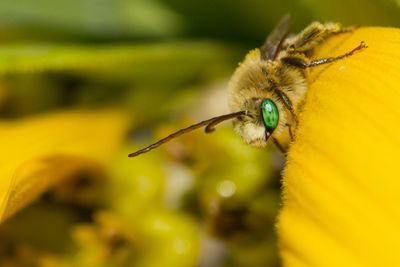Honeybee numbers once dwindled due to colony collapse disorder, but all bees are threatened by pesticide use, loss of habitat, and disease. Local gardeners can help by incorporating pollen and nectar-producing trees, shrubs, annuals, and perennials into their gardens.
Attracting Native Pollinators
It’s important to recognize the difference between social and solitary bees when planning a pollinator garden. Social bees such as European honeybees, paper wasps, bald-faced hornets, bumblebees, and yellow jackets carry their pollen to hives or nests where it is stored as food. If you see one of these nests on your property, treat it with the utmost respect. Keep your distance and minimize any vibration-causing activity near the hive, such as mowing. Social bees will defend their nest and send out the flight squad who may sting their warning. Social bee hives can be recognized by the steady stream of workers in and out of the nest. However, while foraging for nectar and pollen, they mostly ignore people. Native solitary bees such as carpenter bees, mason bees, leaf cutter bees, sunflower bees, sweat bees, and mining bees are either ground nesters or cavity nesters. The entrance to the nest may be so small it is hard to notice. However, solitary bees rarely, if ever, sting. Without a large colony, there isn’t much to defend.
How to Help Native Pollinators in South Central U.S.
Nectar and pollen provide food for native bees and other pollinators, so offering a buffet of woody and herbaceous blooming plants from spring through fall will benefit all the pollinators who need those food sources at different times. Plants that attract South Central pollinators include:
Aster (Aster spp.)
Bee Balm (Monarda fistulosa)
Butterfly Weed (Asclepias tuberosa)
Columbine (Aquilegia canadensis)
Coneflower (Echinacea spp.)
Cream Wild Indigo (Baptisia bracteata)
Coral or Trumpet Honeysuckle (Lonicera sempervirens)
Coreopsis (Coreopsis tinctoria, C. lanceolata)
Goldenrod (Solidago spp.)
Indian Blanket (Gaillardia pulchella)
Ironweed (Vernonia spp.)
Leadplant (Amorpha canescens)
Liatris (Liatris spp.)
Little Bluestem (Schizachyrium scoparium)
Lupines (Lupinus perennis)
Maples (Acer spp.)
Mexican Hat (Ratibida columnifera)
Passion Vine (Passiflora incarnata)
Phlox (Phlox spp.)
Rose Verbena (Glandularia canadensis)
Swamp Milkweed (Asclepias incarnata)
Yellow Wild Indigo (Baptisia sphaerocarpa)
Butterflies and Hummingbirds
By incorporating specific host plants for the caterpillars of native butterflies and moths, you can attract those pollinators to the yard as well. For example, monarch butterflies lay eggs exclusively on milkweed plants (Asclepias spp.). The eastern black swallowtail lays eggs on plants in the carrot family, i.e., Queen Anne’s lace, parsley, fennel, dill, carrots, and Golden Alexanders. Including host plants in your garden will ensure “winged jewels” like this visit. Many of the same nectar plants that attract butterflies, moths, and bees also bring much-loved hummingbirds to the garden. They especially like tubular flowers such as trumpet honeysuckle and columbine.
Nesting Sites for Native Bees
Gardeners can go a step further and make their yards hospitable to nesting native bees. Remember, native bees rarely sting. The ground nesters need bare soil, so keep an area unmulched for them. Log piles and dead trees can provide nesting sites for tunnel and cavity nesters. By providing a diversity of native flowering plant material, it is possible to attract many species of South Central pollinators to local gardens.
